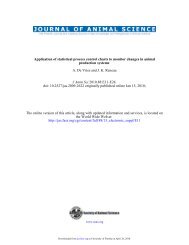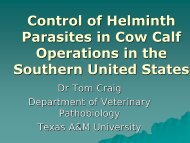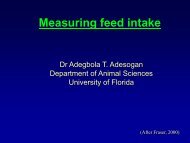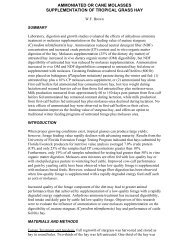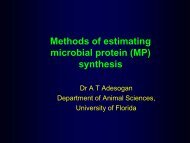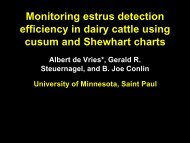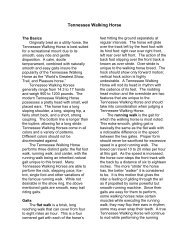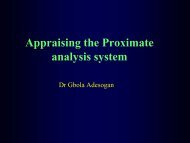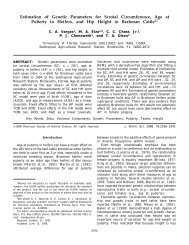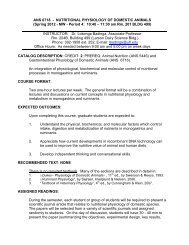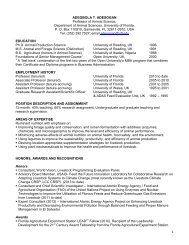Comparison of Different Prostaglandin F2α Treatments in the GnRH ...
Comparison of Different Prostaglandin F2α Treatments in the GnRH ...
Comparison of Different Prostaglandin F2α Treatments in the GnRH ...
Create successful ePaper yourself
Turn your PDF publications into a flip-book with our unique Google optimized e-Paper software.
<strong>the</strong> ground under pasture conditions. On<br />
<strong>the</strong> last day <strong>of</strong> MGA feed<strong>in</strong>g (day 7 <strong>of</strong> <strong>the</strong><br />
experiment), cows were randomly<br />
assigned to one <strong>of</strong> three treatments with<strong>in</strong><br />
each location to receive ei<strong>the</strong>r 5 cc <strong>of</strong><br />
PGF 2α (Lutalyse Sterile Solution ® ), 2 cc<br />
<strong>of</strong> cloprostenol sodium (Estrumate ® ), or<br />
2.5 cc <strong>of</strong> PGF 2α (Split-Lutalyse Sterile<br />
Solution ® ) on days 7 and 8. Cows were<br />
timed-AI and received 2 cc <strong>of</strong> <strong>GnRH</strong><br />
approximately 72 to 80 h after <strong>the</strong> last<br />
MGA feed<strong>in</strong>g.<br />
Cows were exposed to bulls<br />
approximately 10 d follow<strong>in</strong>g timed-AI<br />
for a breed<strong>in</strong>g season <strong>of</strong> approximately 60<br />
d at all locations. Pregnancy status was<br />
determ<strong>in</strong>ed between 52 and 56 d after <strong>the</strong><br />
timed AI us<strong>in</strong>g a real-time B-mode<br />
ultrasound. The data presented <strong>in</strong> this<br />
paper <strong>in</strong>cludes timed-AI pregnancy<br />
(number <strong>of</strong> animals pregnant to <strong>the</strong> timed-<br />
AI divided by <strong>the</strong> number treated) and 30-<br />
d pregnancy rates (number <strong>of</strong> cows<br />
pregnant dur<strong>in</strong>g <strong>the</strong> first 30 d <strong>of</strong> <strong>the</strong><br />
breed<strong>in</strong>g season divided by <strong>the</strong> number<br />
treated).<br />
Results<br />
There was no statistical difference <strong>in</strong><br />
<strong>the</strong> timed-AI pregnancy rates between<br />
PGF 2α treatments (Figure 2). Although,<br />
5% more Estrumate ® treated cows and 3%<br />
more Split-Lutalyse ® cows became<br />
pregnant compared to <strong>the</strong> s<strong>in</strong>gle Lutalyse ®<br />
treatment. For <strong>the</strong> Estrumate ® treatment,<br />
this calculated to 15 extra pregnancies. A<br />
greater number <strong>of</strong> calves born <strong>in</strong> <strong>the</strong><br />
subsequent calv<strong>in</strong>g season could certa<strong>in</strong>ly<br />
have a positive economic benefit to a<br />
producer. Fur<strong>the</strong>rmore, <strong>the</strong> Estrumate ®<br />
treatment does not require <strong>the</strong> additional<br />
cattle handl<strong>in</strong>g required by <strong>the</strong> Split-<br />
Lutalyse ® treatment. Additional research<br />
will need to be conducted with an<br />
<strong>in</strong>creased number <strong>of</strong> cattle and <strong>in</strong><br />
postpartum lactat<strong>in</strong>g cows <strong>of</strong> Bos <strong>in</strong>dicus<br />
breed<strong>in</strong>g to determ<strong>in</strong>e if <strong>the</strong>se results can<br />
be replicated.<br />
The importance <strong>of</strong> body condition on<br />
reproductive function and breed<strong>in</strong>g season<br />
pregnancy rates has been well<br />
documented by scientists and beef<br />
producers. Body condition score can also<br />
<strong>in</strong>fluence <strong>the</strong> effectiveness <strong>of</strong><br />
synchronization protocols. In <strong>the</strong> present<br />
experiment, cows with a body condition<br />
score ≥5 had a 6% <strong>in</strong>crease <strong>in</strong> timed-AI<br />
pregnancy rates (Figure 3) compared to<br />
cows with a body condition score




